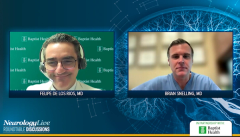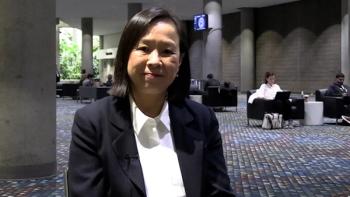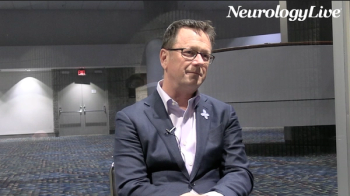
Poststroke Recovery, GLP-1s, and Secondary Prevention

In episode 4, neurologists Brian Snelling, MD, and Felipe De Los Rios, MD, discuss how stroke recovery and secondary prevention have evolved, highlighting new therapies, combination strategies, and the complexities of real-world implementation. [WATCH TIME: 4 minutes]
WATCH TIME: 5 minutes
Across the evolving landscape of stroke treatment, advancements in imaging, intervention, and digital technology continue to redefine what is possible for patients. In this special panel discussion series, neurosurgeon Brian Snelling, MD, and neurologist Felipe De Los Rios, MD, share their expertise from
Over 5 focused conversations, they discuss the major shifts shaping acute stroke management, from expanding thrombectomy eligibility and integrating artificial intelligence into clinical workflows to the promise of neuroprotective agents, modern strategies for recovery and prevention, and the optimization of stroke systems of care. Together, their insights provide an inside look at how data-driven innovation is transforming outcomes for patients across every stage of stroke treatment.
In this discussion, De Los Rios explores how secondary prevention has become more comprehensive, with the introduction of new drug classes, such as glucagon-like peptide 1 (GLP-1) receptor agonists and combination antithrombotics, adding new dimensions to care. De Los Rios, neurologist, Irma Bass Endowed Chair in Stroke Neurology, and director of the stroke program at Baptist Health, shared how clinical decisions increasingly depend on comorbidity profiles, accessibility, and adherence.
Snelling, director of cerebrovascular and endovascular neurosurgery and director of the stroke program at Marcus Neuroscience Institute, turned to the procedural side, describing the lingering challenges of intracranial atherosclerotic disease, the evolving evidence around stenting and angioplasty, and the promise of drug-eluting stents and submaximal angioplasty. Together, they paint a nuanced picture of a stroke recovery landscape that now extends far beyond the acute phase, emphasizing individualized prevention strategies to sustain long-term outcomes.
Transcript edited for clarity.
Felipe De Los Rios, MD: This topic is something we deal with every day in clinic. Poststroke recovery and secondary prevention have evolved dramatically in recent years, and we now have a much broader array of tools to reduce recurrence risk and improve long-term function. The approach has become more complex, not because we’re unsure of what to do, but because there are so many more factors to consider: comorbidities, drug tolerability, access, and patient [adherence] all come into play.
For instance, some patients benefit from dual antithrombotic therapy, such as aspirin combined with low-dose rivaroxaban—2.5 mg twice daily—which has been shown to reduce recurrence in those with advanced atherosclerotic vascular disease. For others, we’re looking more closely at metabolic health. GLP-1 receptor agonists, originally approved for diabetes, are increasingly being used in patients with obesity or prediabetes to reduce cardiovascular and cerebrovascular risk. These therapies can help beyond glycemic control: They improve vascular health overall.
We’ve also seen major changes in lipid management. Statins remain foundational, but now we have PCSK9 inhibitors and other lipid-lowering agents that allow us to push LDL to target levels that weren’t achievable before. So the checklist has grown longer: Is the patient on the right antithrombotic? Are they on optimal lipid therapy? Are their comorbidities—like diabetes, obesity, or sleep apnea—being addressed? And are they able to afford and adhere to these medications? That’s often the biggest challenge.
Brian Snelling, MD: Right, and from the procedural side, intracranial atherosclerotic disease continues to be 1 of the toughest issues we face. The data consistently show that medical management is the first-line treatment, and for most patients, it’s highly effective. But when someone fails medical therapy, the question becomes, What’s next? That’s where we start to hit some gray areas.
Bypass surgery for occlusive or atherosclerotic disease has been studied extensively, but randomized trials didn’t show benefit over best medical therapy. Similarly, intracranial stenting—like the Wingspan system—had high complication rates in earlier studies. That left us with a gap in options for patients who continue to have recurrent strokes despite doing everything right medically.
What’s been interesting over the last several years is the emerging data on submaximal angioplasty—gently dilating the vessel without stenting. In a small subset of patients with high-grade symptomatic stenosis, that technique has shown encouraging results. And now there’s some retrospective evidence suggesting that drug-eluting coronary stents, used off-label intracranially, may perform better than earlier stents, potentially because of lower rates of in-stent restenosis. These aren’t yet supported by large randomized trials, but the early data are promising.
Felipe De Los Rios, MD: That’s a great point. One of the first positive vascular intervention trials for this population was the BASIS trial (NCT03703635), which evaluated submaximal angioplasty. It’s an important signal that we may finally be finding safe ways to intervene mechanically in patients with high-grade intracranial stenosis who remain symptomatic.
Timing is key, though. In the BASIS study, they didn’t intervene right away: They waited several weeks after the acute event to let the plaque stabilize. That’s crucial, because when you try to intervene too early, especially if plaque rupture is the culprit, you risk worsening the injury. Stabilizing with aggressive medical therapy first—statins, dual antiplatelets, and blood pressure control—before attempting any mechanical approach seems to yield the best outcomes.
Brian Snelling, MD: Exactly. We’ve learned that the waiting period makes a difference. We also have to be selective. Not every patient who fails medical management is a candidate for stenting or angioplasty. It depends on the lesion’s location, morphology, and the patient’s overall functional status. We need better data, but I think we’re heading toward a more nuanced, hybrid model, one that combines aggressive medical therapy with carefully timed, minimally invasive interventions when appropriate.
Felipe De Los Rios, MD: And beyond the procedural side, I think we need to remember how central rehabilitation and behavioral factors are in stroke recovery. Medication is critical, but lifestyle management—exercise, diet, managing sleep and mood—all significantly impact outcomes. For many patients, it’s about creating a sustainable care plan that addresses not just stroke prevention but overall brain health.
Brian Snelling, MD: Absolutely. Long-term recovery is multifactorial. The science is getting better, but we still have to focus on implementation—helping patients actually access and adhere to all these therapies. That’s where health systems like ours, with integrated stroke follow-up programs, can really make a difference.
Newsletter
Keep your finger on the pulse of neurology—subscribe to NeurologyLive for expert interviews, new data, and breakthrough treatment updates.



































